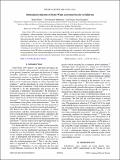Substantial reduction of Stone-Wales activation barrier in fullerene
Author(s)
Kabir, Mohammad Mukul; Mukherjee, Swarnakamal; Saha-Dasgupta, Tanusri
DownloadKabir-2011-Substantial reduction of Stone-Wales activation.pdf (539.4Kb)
PUBLISHER_POLICY
Publisher Policy
Article is made available in accordance with the publisher's policy and may be subject to US copyright law. Please refer to the publisher's site for terms of use.
Terms of use
Metadata
Show full item recordAbstract
Stone-Wales (SW) transformation is a key mechanism responsible for the growth, transformation, and fusion in fullerenes, carbon nanotubes, and other carbon nanostructures. These topological defects also substantially alter the physical and chemical properties of the carbon nanostructures. However, this transformation is thermodynamically limited by very high activation energy (∼7 eV in fullerenes). Using first-principles density functional calculations, we show that the substitutional boron doping substantially reduces the SW activation barrier (from ∼7 to 2.54 eV). This reduction is the largest in magnitude among all the mechanisms of barrier reduction reported to date. Analysis of bonding charge density and phonon frequencies suggests that the bond weakening at and around the active SW site in B heterofullerenes is responsible for such a reduction. Therefore, the formation of the SW defect is promoted in such heterofullerenes and is expected to affect their proposed H2 storage properties. Such substitutional doping also can modify the SW activation barrier in carbon nanotubes and graphene nanostructures and can catalyze isomerization, fusion, and nanowelding processes.
Date issued
2011-11Department
Massachusetts Institute of Technology. Department of Materials Science and EngineeringJournal
Physical Review B
Publisher
American Physical Society
Citation
Kabir, Mukul, Swarnakamal Mukherjee, and Tanusri Saha-Dasgupta. “Substantial Reduction of Stone-Wales Activation Barrier in Fullerene.” Physical Review B 84.20 (2011): [7 pages]. ©2011 American Physical Society.
Version: Final published version
ISSN
1098-0121
1550-235X